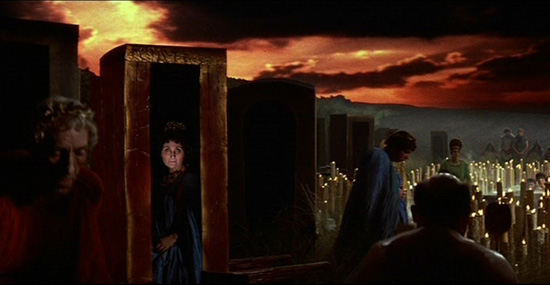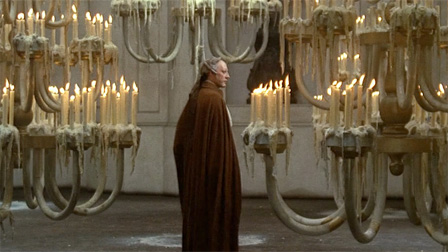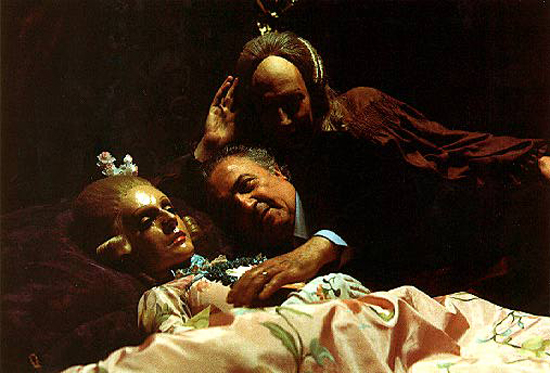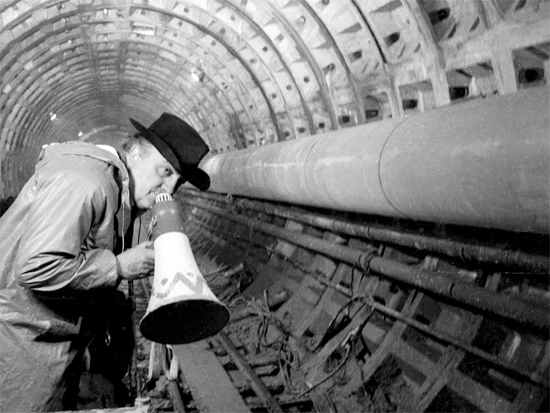It was strangely fitting that the digitally remastered re-release of La Dolce Vita earlier this year was promoted, not by the usual critical garlands and reappraisals, but with a kiss and tell article in The Guardian by Germaine Greer in which she revealed hitherto untold liaison with the great maestro. Fellini always said that his films weren’t autobiographical; it was simply that he had invented his own life purely for the screen. And if his preference for the soundstages of Cinecitta might sometimes make his films seem a little stagey, it is only because each of his films is set, ultimately, in the theatre of his imagination. And what a very peculiar place that turns out to be…
Bertolucci may have been the most erotic of the Italian directors of the mid to late 20th century, and Visconti the most repressed; Bellocchio the most brutal, and Pasolini the most passionate; but Fellini was always the most perverse director. From Peppino de Filippo’s horror at the absurd proportions of Anita Ekberg, bursting out of the poster frame in The Temptation of Doctor Antonio (Fellini’s contribution to the group film, Boccaccio ’70), to the glee of an ageing Marcello Mastroianni in discussing masturbatory fantasies with the actor playing Fellini as a young boy in Intervista, Fellini was always a great chronicler of perversion – but his films, too, were perverse themselves.
It’s rarely appreciated quite how strange and surreal Fellini’s work became from the mid-60s on. Films such as Amarcord, Roma and, most notoriously, City Of Women, offer up a cavalcade of women so fantastically proportioned as to make Robert Crumb blush. In the latter he even resorts to prosthetically enhancing an actress’s posterior as no woman could be found so generously proportioned as Fellini’s imagination required. The body itself thus becomes the locus of fantasy in Fellini’s films, presented never as something merely natural and already given, but as a space of exploration and experimentation, a laboratory of the imagination.

Satyricon, Fellini’s curiously melancholy portrait of pre-Christian Roman hedonism, presents a cavalcade of grotesqueries, farting and rutting with decadent abandon to a soundtrack of avant-garde electronic music by Tod Dockstader and Ilhan Mimaroglu. In casting his films, Fellini would simply place an advert in a local newspaper saying someting along the lines of "Federico Fellini is now ready to see all those who wish to see him". He would then hire an office and waits for the people to turn up. "Every idiot in Rome comes to see me," he would say, "including the police." This unique method of casting ensured that his extras comprise a veritable freakshow of the most curious faces and bodies to have crossed his threshold.
Fellini’s very definition of cinema revolves around "putting certain fantasies in order and telling people about them with some degree of precision". In Marcello Mastroianni, Fellini has the perfect avatar for the unburdening of his fantasies, an actor who settled into middle-age by adopting the role of melancholy satyr and repeating in every film. Fellini always denied that Mastroianni was his onscreen alter ego – albeit in somewhat ambiguous ways, claiming that having Marcello wear a hat of his, making him look like Fellini, was the most direct way for him of getting into the story and its emotions.

Ironic, then, that Fellini’s most sustained paen to perversity – his biopic of history’s greatest pervert, Casanova – starred not Mastroianni but Donald Sutherland. He would say later that he cast Sutherland because he had the "eyes of a masturbator". Throughout the film, Sutherland’s uniquely angular face lends him the air of a man perpetually straining to peer down a woman’s top. The film could scarcely have opened in a more extravagant manner, with hundreds of costumed extras, fireworks, burning boats, and a great statue of the medusa emerging from the sea. From amidst all this we discover the already obscene features of Sutherland, caked in make-up and blond highlights.
Fellini’s Casanova never really comes across as a particularly skilled or amorous copulator – just a particularly dogged one; less the world’s greatest lover than the randiest of old pervs. His first conquest in the film is a nun. As they make love they are watched by an unseen "ambassador" who goes on to review the performance after they have finished (Casanova promptly asks him for a reference). Fellini then, like Lacan, understands perversion as essentially a question of positioning – of the subject’s positioning himself as the object of the other’s enjoyment, his awareness of his own enjoyment as a kind of performance for the other (one thinks here also, of the harried stares straight into the camera on the part of so many of Satyricon’s extras).
As the film progresses, we follow Casanova on his travels, from feast to bed and back to another feast. His feet gently whipped by nuns here, leaping into bed with a life-size mechanical doll there, until finally we see him old and exhausted in Bavaria, laughed at by women, and moaning about his macaroni. As he collapses into a chair in his study, he dreams of a frozen river and a golden chariot – and in his final moments, it is this ersatz woman, this uncanny creature whose eyes had looked so alarmed with the Latin lover beneath her in bed, that comes back to him, and they waltz on the ice amidst the falling snow. Only with this simulacrum of a woman can he find true satisfaction, his hyper-sexuality ultimately revealed as a kind of comic impotence.

It is as a pervert that we are best placed to understand Fellini’s supposedly "ambiguous" attitude to Catholicism, from La Dolce Vita onwards, which brought jeers and whistles from the neo-realists. In fact, there is no ambiguity. In scenes such as the airborne statue of Jesus in La Dolce Vita, the ecclesiatical fashion parade in Roma, Fellini exhibits in fact a true appreciation of Catholicism as the ultimate perverse sect (compare, for example, the more hysteric protestantism of a director like Fassbinder). This scene in Roma lays bare the truly fetishistic nature of Catholic dress, but totally without criticism – Fellini in fact fully shares this fetishistic delight, the impish pleasure and fascination, in the trappings of the church.
For Slavoj Zizek, "Cinema is the ultimate pervert art – it doesn’t give you what you want, it tells you what to desire." Yet Zizek claims to have little time for Fellini, insisting that his films "no longer function today. They are so flatly pretentious." There is a kind of willful half-ignorance towards Fellini on the part of today’s film fans which places him in the curious position of being both wildly over-rated and, simultaneously, tragically under-rated. Everyone is at some point told that Fellini is this great master, and dutifully they all file off to see La Dolce Vita. At the end of the film, everyone thinks, well, that was quite cool, I suppose, a bit boring, but I can’t really see what the fuss is about, and thus learns to pride themselves on having exploded this great sacred cow of classical film studies. In this glib, overhasty dismissal, the young cineaste both saves himself the effort of actually engaging with Fellini’s stranger work and flatters himself as an anti-canonical nonconformist in the process, learning instead to lionize the more officially sanctioned weirdness of Jodorowsky and Lynch (neither of whom are really half as radical or peculiar as Fellini himself).
Yet it is through Fellini that we can best understand Zizek’s thesis on cinema as perversion – and through the structure of perversion that we can best understand Fellini’s quarrel with the neo-realists. In Zizek’s famous analysis of the scene in The Matrix in which Neo is offered two pills – one to maintain the fantasy illusion of "reality" the other offering unfiltered access to the desert of the Real, Zizek claims that what he really wants is a third pill, a pill to demonstrate the reality in the fantasy. This ‘pill’ is precisely the medicine served by the work of Fellini. In strict opposition to the verismo methods employed in such films as La Terra Trema or Roma Citta Operta, the promise of reality’s immediate, unmediated capture by the cinematic apparatus, Fellini offers a reality more real precisely because it is fake. "I cannot help feeling," Fellini once claimed, "that the real Via Veneto is the one on Stage Five [at Cinecitta Studios]."


